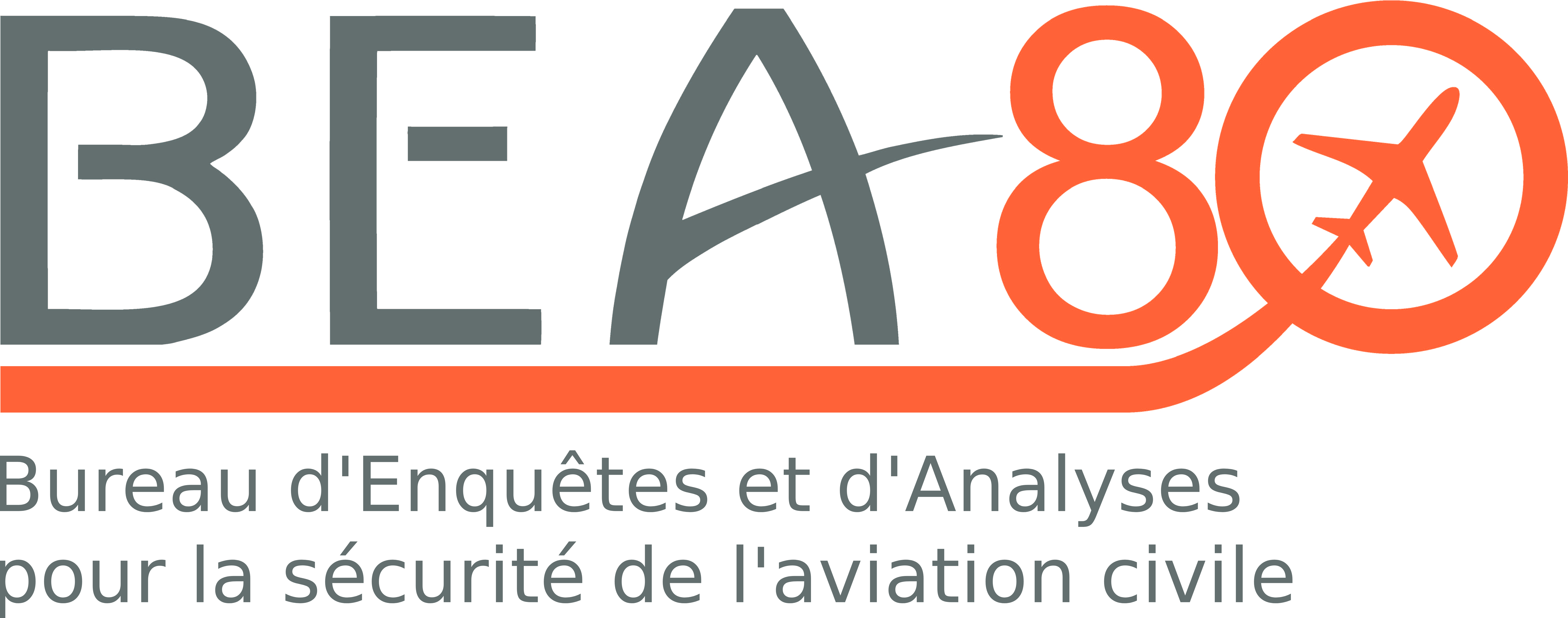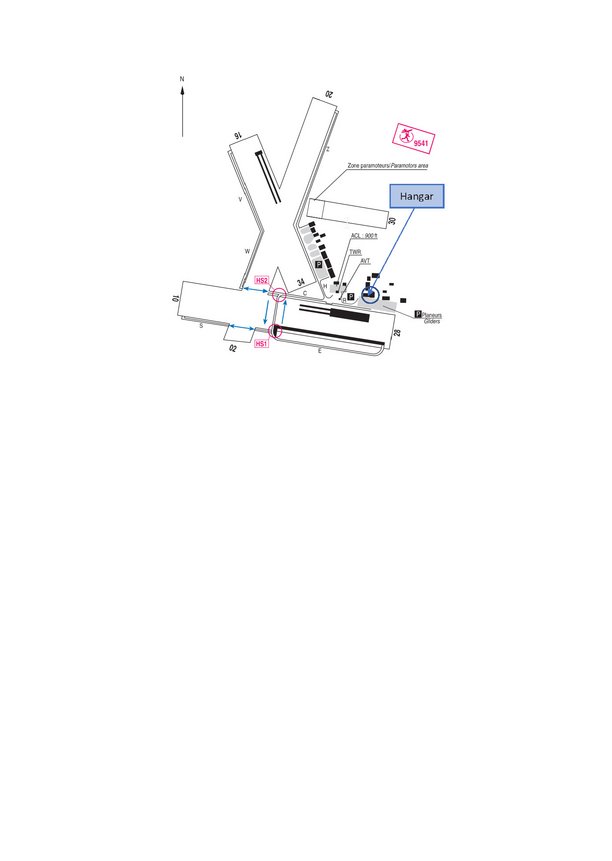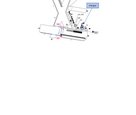Accidents to the Scheibe - SF28 - A registered F-CFJB on 19/12/2021 at Vinon-sur-Verdon aerodrome (Var) and Eyguières aerodrome (Bouches-du-Rhône)
Atterrissage à côté de la piste, collision avec un arbre pendant le roulement, de nuit
Cat. 3 investigation report: report concerning an occurrence with limited consequences, based on one or more statements not independently validated by the BEA.
This is a courtesy translation by the BEA of the Final Report on the Safety Investigation published in March 2022. As accurate as the translation may be, the original text in French is the work of reference.
Note : The following information is principally based on statements made by the pilot and other members of the gliding club (CVVC). This information has not been independently validated by the BEA.
1 - HISTORY OF THE FLIGHT
The pilot took off from Eyguières aerodrome at 16:22 to carry out two runway circuits before leaving the powered glider with another pilot before the start of the aeronautical night[1]. After take-off, he decided to go to Vinon-sur-Verdon aerodrome. The members of the CVVC at the aerodrome worried at not seeing him come back as he had said he was going to carry out two runway circuits, discovered on OGN[2] that he was heading towards Vinon-sur-Verdon. They tried to contact him by phone and radio, without success (the pilot remembered that he was euphoric during the flight and that he had forgotten to turn on the radio and his cell phone). The pilot landed at 16:58 on paved runway 28 for aeroplanes at Vinon-sur-Verdon aerodrome. When they realized that he had landed, the CVVC members tried to contact the Association Aéronautique Verdon Alpilles (AAVA) by phone to stop the pilot from taking off again, without success. The pilot then taxied to the glider parking area using taxiways C and R (see Figure 1) to reach the holding point of runway 28 for aeroplanes and take off again. On arriving in the parking area, the powered glider’s left wingtip hit a post and its propeller stuck a hangar door. The pilot shut down the engine, noticed that the hangar door was unhinged and that the left wingtip was broken. He did not notice the substantial damage to the left wing which was deformed and decided to leave. He moved the powered glider by hand and taxied to the holding area of paved runway 28 for aeroplanes. He took off at 17:19 (twelve minutes before the start of the aeronautical night) and headed for Eyguières aerodrome.
During the flight, because of the significant decrease in luminosity, the pilot had to illuminate the instruments with the light of his cell phone. Using ground lights for reference, he managed to reach Salon-de-Provence, by-passed the town by the south and then headed for the interior of the Eyguières aerodrome grounds in order to land on runway 33, without having it in sight. In the meantime, the CVVC members switched on the hangar lights, then drove to the threshold of runway 33 to illuminate it with their headlights. However, by the time they arrived, the powered glider was already landing. The pilot landed inside the aerodrome grounds, at 17:52 (17 minutes after the start of the aeronautical night[3]) but about 150 m to the left of unpaved runway 33. During the landing run, the glider hit a tree and the right wing was torn off.
After the aircraft had come to rest, the pilot exited the powered glider unaided. The CVVC members who came to help him noticed that he behaved abnormally. An alcohol test conducted by the police shortly after the accident was positive.
2 - ADDITIONAL INFORMATION
2.1 Information about Vinon-sur-Verdon aerodrome
The aerodrome is not approved for night VFR. The Visual Approach Chart indicates that the aerodrome is limited to aircraft with a wingspan of less than 15 m, with the exception of powered gliders.
The Visual Approach Chart specifies that after landing on paved runway 28 “plane circuit”, the pilot must clear the runway left-hand by HS1 or taxiway S.
2.2 Eyguières aerodrome information
The aerodrome is not approved for night VFR and it is not equipped with any lighting. It has two intersecting grass runways. Unpaved runway 33 is 1,220 m long and 150 m wide (see Figure 2).
2.3 Pilot information
The 60-year-old pilot held a glider pilot license issued in 2001 and a powered glider rating (TMG). He did not hold a night VFR rating. According to his logbook, he had logged about 475 flight hours and 15 hours and 30 minutes in the previous three months, including approximately eight hours on type. The pilot reported approximately 280 flight hours on the SF28. In 2021, he had flown about 30 hours on F-CFJB. He had been a member of the CVVC since 1999, and according to the president, he was a very disciplined and experienced person on the SF28, with no known alcohol problems in the CVVC up to that point.
After the accident, an alcohol breath test conducted at approximately 19:00 showed an alcohol level of 0.44 mg/l of exhaled air. Based on the alcohol elimination models, it can be concluded that the pilot's alcohol level during the flight could have varied between 0.52 and 0.67 mg/l of exhaled air.
2.4 Deterioration of abilities due to alcohol consumption
The 17th edition of the Aeroplane Pilot's Manual published by CEPADUES reminds us that alcohol and drugs constitute a serious risk for flight safety, including flight safety in general aviation. The associated impairments to performance are considerable: increased reflex time, degraded judgment capabilities, impeded risk assessment, worsening of sensory illusions. It is not necessary to be in a significant state of inebriation for these effects to appear.
The European regulation (EU) No 965/2012 known as "AIR OPS[4]" indicates in annex VII - Part NCO Non-commercial operations with other than complex-motor-powered aircraft that, ”The pilot-in-command shall be responsible for [...] not commencing a flight if he/she is incapacitated from performing duties by any cause such as injury, sickness, fatigue or the effects of any psychoactive substance.”[5]
A Safety Information Bulletin (SIB 2018-07: "Blood Alcohol Concentration Limits for General Aviation Pilots") was posted on the European Aviation Safety Agency (EASA) website on 12 April 2018. The document clarifies the previously mentioned requirement by stating that, “The breath alcohol concentration (BrAC) should not exceed the lower of the national limit or 90 micrograms of alcohol per litre of breath, whilst performing duties related to operating an aircraft, including flight preparation.”
To this end, the SIB recommends refraining from consuming alcohol eight hours prior to performing duties related to operating an aircraft, including flight preparation, and increasing that length of time if necessary to account for the amount of alcohol consumed.
The SIB indicates that, “Pilot training organisations and aero clubs should consider these recommendations under their risk management responsibilities. Competent authorities should consider these recommendations in the context of their oversight of General Aviation pilots operating under their responsibility.”
2.5 Statements
The pilot said that he asked a pilot friend to meet him at his hangar on the aerodrome because he was depressed and wanted to take his mind off the situation. His friend explained that when he arrived at 14:00, the pilot offered to fly. He accepted and carried out the pre-flight inspection while the pilot was closing his hangar, and then waited for a long time by the powered glider for the pilot to join him. The pilot indicated that there was a bottle of whiskey in his hangar and that he had had two drinks shortly before proceeding to the powered glider.
Before getting into the powered glider, the pilot talked with an instructor to whom he explained that he had had problems with alcohol in the past but that it was all sorted out[6]. When he got into the powered glider, the pilot told his friend that he did not have the keys. The latter went to get them and, on coming back, suggested postponing the flight to the next day, as it was already late (about 16:30). The pilot refused and said he would carry out two runway circuits. His friend stayed on the ground.
The pilot's friend stated that he was wearing a mask for health reasons (COVID-19) and did not smell any alcohol. Several people who spoke with the pilot before the flight affirmed they had not noticed anything unusual about his behaviour[7].
The pilot explained that he did not have a watch and that when he left Vinon-sur-Verdon, he did not know what the time was. He nevertheless thought that there was enough light to take off and it was on the way back, a little sobered, that he realized it was night. He intermittently illuminated the altimeter, airspeed indicator, vertical speed indicator and compass with his cell phone. When he landed at Eyguières, he did not see the car headlights that were illuminating the runway. He specified that despite the situation, at no time did he think of asking for help by radio or by phone.
[1] Sunset at Eyguières: 17:05.
[2] Open Glider Network (The powered glider had a FLARM).
[3] Sunset at Vinon-sur-Verdon: 17:01.
[4] Regulation of 5 October 2012 laying down technical requirements and administrative procedures related to air operations.
[5] Any product or chemical substance, altering brain functions and inducing modifications in perception, sensations, mood, consciousness or other psychological or behaviour functions. Alcohol is a psychotropic substance.
[6] A witness said that he had seen the pilot, two or three years before, drinking one or two glasses of alcohol in his hangar and that he had not flown that day. A person with an alcohol problem, even and especially when he is teetotal, is in danger as soon as alcohol becomes accessible to him.
[7] Attention is generally focused on the state of drunkenness (the most well-known manifestation of alcohol intoxication) which is a late warning signal. However, in the case of an alcoholic, at the stage of dependence which affects about 10 to 15% of consumers, he or she may present few visible symptoms, or voluntarily conceal a sometimes significant alcohol consumption.




